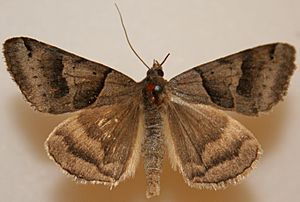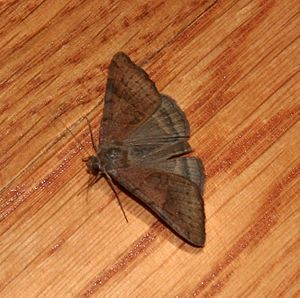Forage looper facts for kids
Quick facts for kids Forage looper |
|
|---|---|
 |
|
| Male | |
 |
|
| Female | |
| Scientific classification | |
| Genus: |
Caenurgina
|
| Species: |
erechtea
|
| Synonyms | |
|
|
The forage looper or common grass moth (scientific name: Caenurgina erechtea) is a type of moth. It belongs to a large family of moths called Erebidae. This moth was first officially described by a scientist named Pieter Cramer in the year 1780.
About the Forage Looper Moth
The forage looper moth is known by two common names: the forage looper and the common grass moth. These names give us clues about where it lives and what it eats! It's a very common moth across North America.
Where They Live
You can find the forage looper moth almost everywhere in the United States. It also lives in many parts of Canada. However, it does not live in some colder Canadian regions. These include Newfoundland, New Brunswick, Prince Edward Island, Yukon, and the Northwest Territories.
What They Look Like
These moths are medium-sized. Their wingspan (the distance from one wingtip to the other) is usually between 30 and 42 millimeters. That's about 1.2 to 1.6 inches. Adult moths can be seen flying around for many months. Depending on where they live, you might spot them from March all the way to November.
What They Eat
The young moths, called larvae or caterpillars, have specific food preferences. They enjoy eating plants like Ambrosia trifida, which is also known as giant ragweed. They also munch on different kinds of clover, various types of grass, and alfalfa. These plants are common in fields and meadows, which is why the moth is sometimes called the "forage looper."

